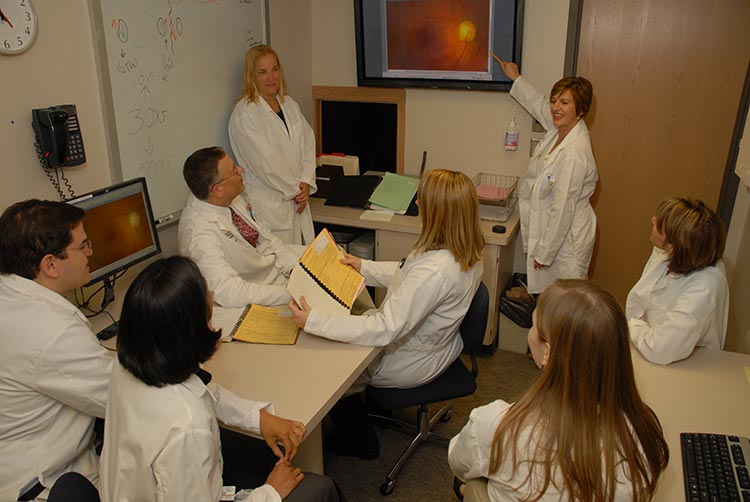Patient Care
Patient care is supervised by our faculty both clinically and surgically.
- Lindsay De Andrade, MD
- Arlene V. Drack, MD
- Alina V. Dumitrescu, MD, FACS
- Pavlina S. Kemp, MD
- Scott A. Larson, MD
- William E. Scott, MD, emeritus professor
Fellow responsibilities include outpatient and inpatient clinical and surgical experience. Outpatient clinics are found in the Department of Ophthalmology and in the Pediatric Specialty Clinic. Inpatients are seen in the UI Stead Family Children’s Hospital. All clinics and hospitals are on the same campus in Iowa City.
The fellow's surgical experience includes over 300 surgeries as a primary surgeon. This includes approximately, 230 strabismus surgeries, varying in range from common to complex, with a strong representation of adult strabismus, oblique and vertical muscle surgery, re-operations, and adjustable suture techniques. On average, fellows are involved in 15 to 20 pediatric cataract surgeries per year and learn nasolacrimal surgery including nasolacrimal duct probing and stenting. The fellow participates in weekly retinopathy of prematurity examinations with faculty guidance, and participates in treatment of severe ROP. Fellows are actively involved in diagnosis and management of pediatric ocular genetic diseases and ocular tumors, including intraocular injections, laser, cryo treatment, chemotherapy, and enucleations. The pediatric ophthalmology fellow also works with the glaucoma, retina, cornea, and oculoplastics services to achieve a broad experience in clinical and surgical management of all aspects of pediatric eye disease.
Education
The Pediatric Ophthalmology and Strabismus Fellowship is part of a long tradition of educational excellence in ophthalmology education.
Since the fellowship’s beginnings, nearly a hundred fellows have come to receive specialized training in pediatric ophthalmology and strabismus at University of Iowa. In 1951, Dr. Herman M. Burian came to Iowa and began a division of ocular motility and binocular vision. He began training fellows in strabismus. Many influential ophthalmologists came to learn under Dr. Burian including Bruno Bagolini, Albert Francheschetti, and Gunter von Noorden. Under the leadership of William E. Scott, MD in 1973, the fellowship expanded to include pediatric ophthalmology. Scott developed a system of teaching strabismus summarized in the Iowa Strabismus Notes.
Our fellows take an active role in all teaching conferences and journal clubs. They also participate in department-wide grand rounds, lectures, and clinical conferences. They are active in the clinical teaching of residents, medical students, and orthoptic students.
 Research
Research
Fellows are encouraged to participate in research and present at regional and national meetings, including the AAPOS annual meeting. Funding for national meeting presentations is provided. Fellows also present at the annual University of Iowa Ophthalmology Residents' and Fellows' Research Day.
Faculty research interests include juvenile inherited eye diseases and development of novel treatments, as well clinical and surgical outcomes of strabismus and cataract. In addition to ongoing clinical and basic research, the department participates in Pediatric Eye Disease Investigator Group (PEDIG) studies. Fellows are encouraged to contribute to research efforts, with dedicated faculty guidance and mentorship.
Salary and Benefits Summary
Salary is based on a post-graduate training level and is set by the Graduate Medical Education (GME) office. Most fellow physicians are paid at the PGY-5 level. Read more about benefits.